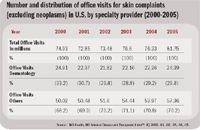- Acne
- Actinic Keratosis
- Aesthetics
- Alopecia
- Atopic Dermatitis
- Buy-and-Bill
- COVID-19
- Case-Based Roundtable
- Chronic Hand Eczema
- Drug Watch
- Eczema
- General Dermatology
- Hidradenitis Suppurativa
- Melasma
- NP and PA
- Pediatric Dermatology
- Pigmentary Disorders
- Practice Management
- Precision Medicine and Biologics
- Prurigo Nodularis
- Psoriasis
- Psoriatic Arthritis
- Rare Disease
- Rosacea
- Skin Cancer
- Vitiligo
- Wound Care
Article
Easing the derm shortage
Kingston, N.Y. - Training board-certified primary care physicians in medical dermatology could be one way to help alleviate the shortage of medical dermatologists in the United States, according to Marie-Louise Johnson, M.D., in practice in Kingston, N.Y.

Dr. Johnson says she expanded her practice facilities to create the comprehensive Skin Center, adequate to support a fellowship program to train board-certified primary care physicians to achieve expertise in medical dermatology.
The educational sponsor is a local residency program approved by the American Board of Family Medicine, says Dr. Johnson, who will turn 80 years old this year.
"I direct the clinical practicum of the program. The fellows spend one day per week in New Haven - 100 miles distant - participating in the Yale Dermatology Residents Educational Program," she says. "Fellows are expected to spend three years on the staff of the Skin Center. In July 2006, I selected, in addition, an outstanding master's level physician associate for fellowship training."
The shortage

Dermatologists accounted 20 years ago for 38 percent of such care; in 2005, it was 29.9 percent, Dr. Johnson says.
"There are relatively few dermatology practitioners - about 10,000, or 3.3 per 100,000 population - and they cluster in urban sites," she tells Dermatology Times.
"Due to the high prevalence of cancer in an aging society and strong demand for cosmetic surgery and procedures, medical dermatology is no longer the seminal component of dermatologic practice. Practitioners have sought relief by adding PAs and NPs to their staff," she says, adding that both primary care physicians and nonphysician extenders have had little (if any) instruction in dermatology in their professional school and in residency training.
"Due to the small national annual production of dermatologists, about 320, and their practice selection of urban sites, vast U.S. rural and semirural areas, now with one to two dermatologists per 100,000 population, are slated to be without a dermatologist," Dr. Johnson says. "Their old medical dermatologists - a vanishing species - retire without replacement."
In Dr. Johnson's area, all the dermatologists are aging, and there appears to be no one to replace them.
"The sad part is that so much of what the dermatologist knows today as far as lupus or bullous diseases are concerned will be lost. Patients are going to be taken care of by physicians who have no knowledge of the diagnosis. This to me is a tragedy," she says.
Therefore, Dr. Johnson decided that it is better to hone the skills of the primary care doctor who is going to see these patients anyway.









